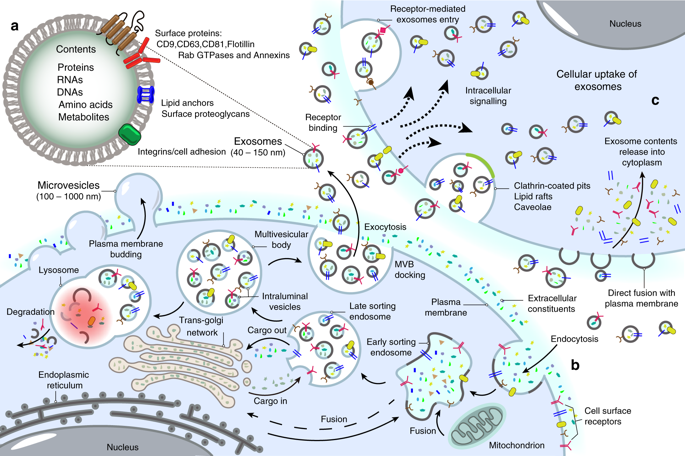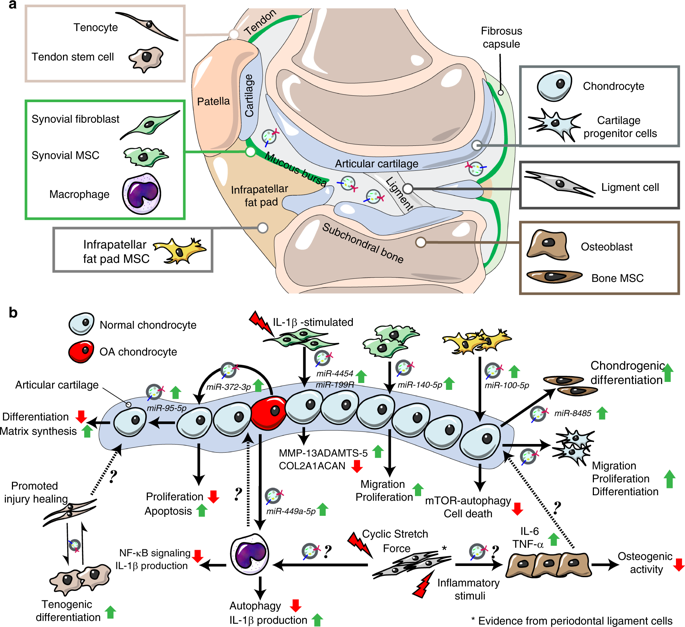Abstract
Exosomes are involved in many physiological and pathological processes by regulating cell-to-cell communication involved in various diseases including osteoarthritis (OA). Exosomes were detected in the joint cavity of humans and were observed to change with OA progression. Several types of joint cells, including chondrocytes, synovial fibroblasts, osteoblasts, and tenocytes, can produce and secrete exosomes that affect the biological effects of target cells. Stem cell exosomes can protect OA joints from damage by promoting cartilage repair, inhibiting synovitis, and mediating subchondral bone remodeling. This review summarizes the role and therapeutic potential of exosomes in OA.
Content
Osteoarthritis (OA) is a very common degenerative joint disease, affecting more than 300 million people worldwide. Chronic pain and motor dysfunction caused by OA severely reduce patients’ quality of life. Exosomes are considered to be important mediators of intercellular communication and are involved in many physiological and pathological processes. Recently, the role and therapeutic potential of exosomes in OA have received increasing attention in this field.
Exosomes – intercellular communication mediators
Extracellular vesicles (EVs) are membrane-bound mediators that can be classified into three categories, including exosomes, microvesicles (MVs), and apoptotic bodies. As an important EV, exosomes have received the most attention in the past decade. Exosomes can be secreted by various cells and mediate cell-to-cell communication through their contents, including lipids, nucleic acids, and proteins. The diameter of exosomes is usually between 30-150 nm and the density is between 1.13 and 1.19 g/mL.
Trams et al. found that shed membrane vesicles may have physiological functions and suggested that these vesicles are exosomes. In 1983, Harding et al. observed that membrane-bound vesicles can be released by multivesicular endosome (MVE) exocytosis. Subsequently, the researchers discovered that transferrin receptors can be translocated from the cell surface into internal vesicles to form MVEs. In 1987, Johnstone et al. observed that the release of exosomes during reticulocyte maturation was associated with plasma membrane activity. Raposo et al. later found that exosomes played an important role in antigen presentation and T cell activation. Then, the relationship between exosomes and tumors was reported. In 2007, Valadi et al. found that exosomes can deliver mRNA and microRNA to other cells, suggesting that exosomes can mediate cell-to-cell communication by delivering nucleic acids. Since then, more and more studies have shown that exosomes play important physiological and pathological roles by mediating cell-to-cell communication. Exosomes contain different types of proteins, nucleic acids, amino acids, and metabolites, among which CD9, CD63, CD81, flotillin, and annexins can be used as markers. The identification of exosomes is mainly based on morphological characteristics, particle size, and characteristic proteins such as CD9, CD63, CD81, and HSP90.

Fig.1 Exosome Biogenesis
Over the past few decades, exosomes have been found to affect several physiological and pathological processes through exosomal contents including RNA, DNA, proteins, and lipids. To date, accumulating evidence suggests that exosomes are involved in many biological processes, including angiogenesis, cell differentiation, immune regulation, metabolic homeostasis, and development, and are highly involved in many diseases such as cancer, neurodegenerative diseases, autoimmunity disease, and cardiovascular disease. Recently, the role of exosomes in bone homeostasis has been extensively studied. Bone homeostasis is primarily maintained through bone resorption and bone formation, which involves various types of cells, including osteoblasts, osteoclasts, osteocytes, and MSCs. Abnormalities in skeletal homeostasis are closely related to skeletal diseases in several ways, such as affecting the occurrence and progression of osteoporosis and wound repair of fractures. Many studies have shown that cells in the skeletal microenvironment can secrete exosomes to regulate bone resorption and bone formation.
Exosomes and OA
The role and underlying mechanisms of exosomes in OA have aroused great interest among researchers. To date, there are two main research directions in this field. Studies have focused on the diagnostic significance and biological role of endogenous exosomes during OA (Figure 2). In addition, the researchers focused on the therapeutic effects of stem cell-derived exosomes on OA and potential optimization strategies (Figure 3).

Fig. 2 Exosomes in different tissues of OA joint and their potential biological effects

Fig. 3 Therapeutic effects of stem cell-derived exosomes on OA and potential optimization strategies
Several studies have shown that exosomes are present in human synovial fluid (SF). Furthermore, in joint diseases such as OA, rheumatoid arthritis, and reactive arthritis, the number and composition of SF-derived exosomes may change. At the same time, exosomes are also found in cartilage, subchondral bone, MSC, and other tissue cells, which are also discussed and summarized in this article.
Exosomes in OA underlie physiological functions in intercellular communication and signal transduction. Exosome contents including microRNAs, long non-coding RNAs, DNA, lipids, and proteins may change with disease progression and greatly contribute to the pathological changes of the disease. In addition, the exosome content is also closely related to the therapeutic effect of MSC-derived exosomes on the repair and regeneration of damaged tissues. To date, a growing body of work has revealed the important role and underlying mechanistic processes of exosome content during OA, including miRNAs, lncRNAs, and proteins. However, the lipid composition of other types of RNAs and exosomes in OA pathology has not been reported and requires further investigation.
Summary
As an important intercellular communication mediator, exosomes greatly promote the occurrence and development of OA and show a strong therapeutic potential for OA. Exploring the detailed mechanism of exosomes in the pathological changes of OA will help to screen and identify potential therapeutic targets. Furthermore, MSC-Exos need to be optimized to improve their therapeutic effect on OA. Research on the role, underlying mechanisms, and diagnostic/therapeutic applications of exosomes in osteoarthritis has just begun, and there are still many questions to be addressed in this field. With the advancement of technology, exosome-based therapy will be applied to OA patients in the future.
